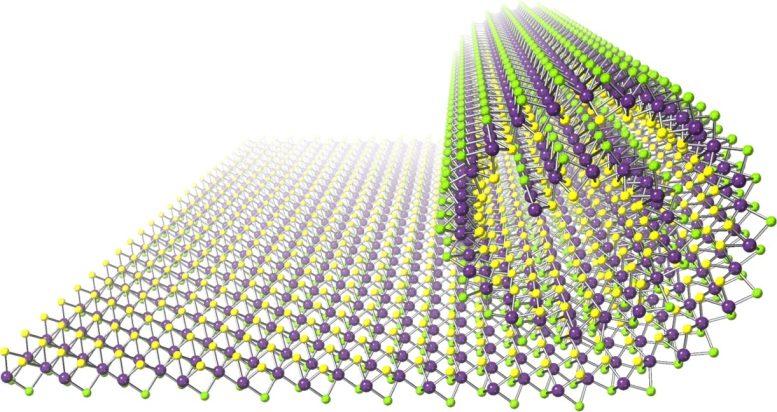
By replacing the atoms on one side of the nanosheet with a different element, the team has realized a nanosheet that can spontaneously roll into a scroll when detached from its substrate. Credit: Tokyo Metropolitan University
Janus nanosheets bring unprecedented control to preparation of nanoscrolls.
Researchers from Tokyo Metropolitan University have come up with a new way of rolling atomically thin sheets of atoms into “nanoscrolls.” Their unique approach uses transition metal dichalcogenide sheets with a different composition on either side, realizing a tight roll that gives scrolls down to five nanometers in diameter at the center and micrometers in length. Control over the nanostructure in these scrolls promises new developments in catalysis and photovoltaic devices.
Advancements in Nanotechnology
Nanotechnology is giving us new tools to control the structure of materials at the
A New Method for Nanoscroll Production
In their latest work, they set their sights on new ways of making nanoscrolls, nanosheets rolled up into tight scroll-like structures. This is an attractive approach for making multi-walled structures: since the structure of each sheet is the same, the orientations of individual layers are aligned with each other.
However, the two existing ways of making nanoscrolls have significant issues. In one, removing sulfur atoms from the surface of the nanosheet creates distortions that cause the sheet to roll up; but by doing so, they destroy the crystal structure of the sheet. In the other, a solvent is introduced between the nanosheet and the substrate, loosening the sheet from the base and allowing the formation of defect-free nanoscrolls. However, tubular structures made like this tend to have large diameters.
Breakthrough With Janus Nanosheets
Instead of approaches like this, the team have come up with a new way of causing sheets to roll up. Starting with a monolayer molybdenum selenide nanosheet, they treated the nanosheet with a SciTechDaily